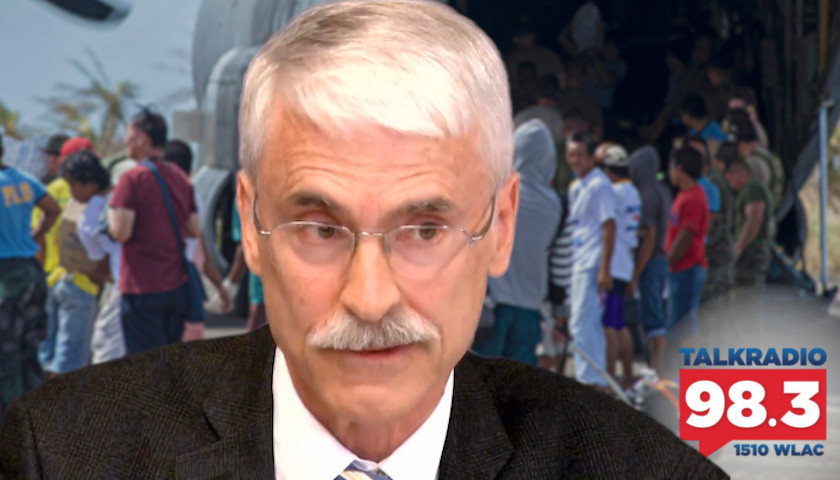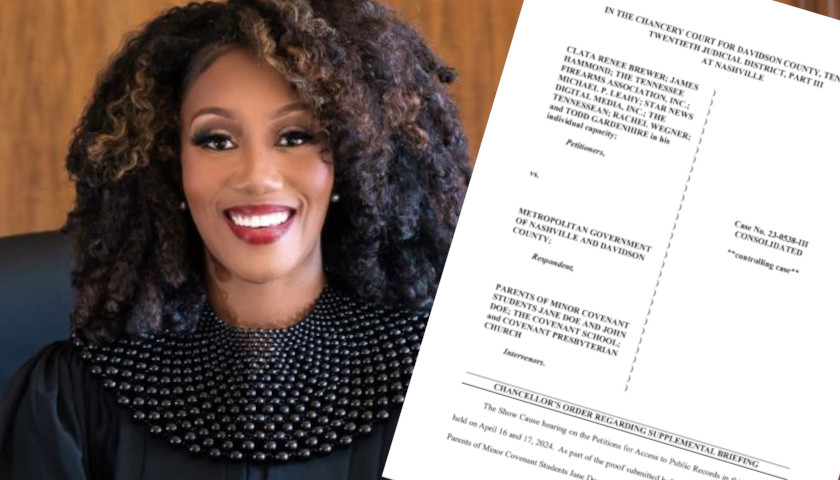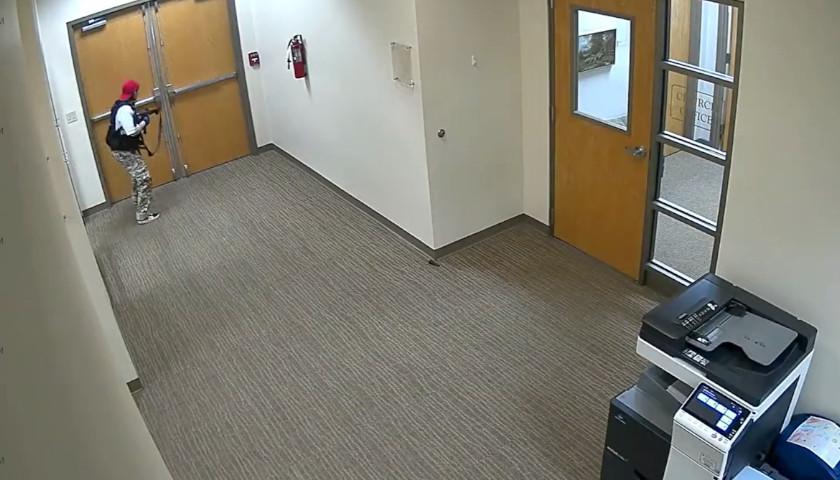On Wednesday’s Tennessee Star Report with Michael Patrick Leahy – broadcast on Nashville’s Talk Radio 98.3 and 1510 WLAC weekdays from 5:00 a.m. to 8:00 a.m. – host Leahy welcomed Don Barnett in the studio to speak about the cost effects of illegal immigration and refugee resettlement on the American taxpayer.
During the second hour, Barnett highlighted the true cost of refugees and cited the number of refugees that have been admitted under Obama’s last year and the lesser number under the Trump administration.
He went on to explain that refugees receive immediate welfare benefits and described how illegal immigrants game the system by approaching border patrol claiming asylum. Barnett said the majority of the immigrants seeking asylum rarely turn up for their court cases and disappear into the country.
Leahy: And we are delighted to welcome to our microphones all-star panelist, a good friend for a long time. A resident of Middle Tennessee and a fellow with the Center for Immigration Studies Don Barnett. Good morning Don.
Barnett: Good morning Michael.
Leahy: And Don, you gave a terrific presentation last week at the Tennessee Star Wilson County Refugee Resettlement Town Hall. I don’t think there is anybody in the country that I know of, and I’ve been writing about this for five or six years at Breitbart.
And then we’ve been covering it at The Tennessee Star. I don’t think anybody in the country has written more clearly and in greater detail about the true costs of refugee resettlement. What struck me in your presentation, which was very very strong and very fact-based, was just how many expenses are born by the taxpayers from this refugee resettlement program.
Barnett: Right. It’s quite a costly program. I think that’s the point of the program that the official costs which run somewhere around two to three billion a year. That’s the official cost.
Leahy: The official cost if you go and you ask the federal government. The parts of the Department of Health and Human Services.
Barnett: Add it all up.
Leahy: And they say it’s like two or three billion with a “b.”
Barnett: Correct.
Leahy: And what your saying is really understated.
Barnett: That’s basically just bus fare (Leahy Laughs) to get individuals over and into the system.
Leahy: Wow.
Barnett: Once they get into the system, that’s when the costs really start adding up.
Leahy: Yeah. And you went through this list of all of the costs that both federal and state taxpayers pay for this program. Just for our listeners who may not be familiar with all of the costs that they bear for refugees. Just give us an overview of the program and then what some of those costs are.
Barnett: Well the real costs come in with the eligibility for welfare.
Leahy: Oh. They’re all eligible for welfare?
Barnett: Upon arrival. Eligible for welfare.
Leahy: OK. Upon arrival?
Barnett: Right. There are actually a number of categories that have this privilege. In fact, one out of five legal immigrants to the US are coming as clients of the Office of Refugee Resettlement.
Leahy: One out of five. This is legal immigration.
Barnett: This is legal.
Leahy: So they are legal. And just for our listeners, the Refugee Act of 1980 established the refugee admissions program since 1980. Now it’s 40 years.
Barnett: Sponsored by Joe Biden which I’m surprised it’s never been brought up in his run. Not sure who would remember he sponsored it. (Leahy laughs)
Leahy: There’s a lot of things ole Joe is not remembering like which office he’s running for. It’s the president. It’s not Senate by the way.
Barnett: Right.
Leahy: So in those 40 years, there is a legal way for refugees from countries, and there are some conditions. About three million refugees have come into the United States legally under that program. It’s averaged over time to maybe 50-70,000 per year.
Under President Obama’s last year was 85,000. And this year under President Trump another one of his many other promises which he’s been honoring, 18,000 under the law the president sets a cap for these refugees. And President Trump has set it at 18,000. Now, what are the conditions? What are the requirements to qualify for entry under this program?
Barnett: Well one thing to point out, to get to the one out of five legal immigrants being plants of the Office of Refugee Resettlement, we do have to bring up the other categories all of which are eligible for welfare right away.
Leahy: Due to the generosity of the American taxpayer.
Barnett: Extremely heavily. It’s known worldwide that this is the deal.
Leahy: The American gravy train right? Let’s get on that American gravy train!
Barnett: It’s like a free pass to Disneyland. (Leahy laughs) Besides refugees, that would be asylum seekers under the same law of the 1980 Refugee Act. Those that manage to get over on their own and convince a judge that they are an asylum seeker also get this right.
When it was originally passed in 1980 there was a cap of 2000. Now there’s no cap at all. So we get roughly 25,000 successful asylum seekers a year. Cuban, Haitian entrance which got up to about 87,000 a year in 2016.
It got so out of control that even Obama decided it had gone too far, and he scaled the program back quite a bit. He didn’t end it completely as he said he was going to. Of course, he ended it for the wrong reasons.
He ended it because he was trying to make nice with Cuba (Leahy laughs) but the reality is that probably more than three million Cubans have come over also under the so-called Cuban-Haitian entry program. Also with full access to welfare.
There’s quite an interesting investigative study on how to the extent to which they instrumentalized the welfare. Getting on welfare programs and going back to Cuba and staying on the welfare program.
Leahy: Oh really? Bernie Sanders must love that.
Barnett: Yes. Yes.
Leahy: So under that part of the program, which is separate from the refugee program.
Barnett: There’s one more category.
Leahy: Oh there’s another category. My head is spinning with all the ways we can give money.
Barnett: As very small numbers for asylum seekers, for instance, the INS director said well, we want to make it safe for the few ballet dancers who decide to defect. (Leahy laughs) He thought maybe 1,000 year. It’s now up to 30,000 a year.
Leahy: Lots of ballet dancers out there apparently.
Barnett: Right. There are special immigrant visas out there. Which is for Afghans and Iraqi’s that served as interpreters. And in some cases just came in and took out the garbage and the consulate then said yeah.
Leahy: Just to clarify. The refugee program where this year only 18,000 are coming into the United States in which Governor Bill Lee said yes to when he could have said no back in December. That’s a program where you have to meet a bunch of qualifications. You’ll talk about in a second.
And you go through this United Nations “vetting process.” And they give you a little gold star. And if you get a gold star you get to come into the United States. Under the asylum program, you don’t have to go through all that stuff. You just show up here in America, and you put your hand up and say I want asylum. That’s how that works.
Barnett: You still have to prove that you are persecuted owing to the fact of either particular religion, a race, a nationality, a political opinion, or a social group.
Leahy: How hard is that?
Barnett: At times it’s been extremely easy to fake social group or political opinion. In fact, there’s almost nothing to it.
Leahy: Yeah.
Barnett: But, indeed, most asylum seekers that hit our shores, for instance, believe it or not. We had about 975,000 border crossers in 2019. The vast majority of those gave themselves up to border patrol and said I am seeking asylum.
The vast majority of that group was let into the country to await their asylum hearing. Most of them will not pass the asylum test. They still will remain in the country anyway. Most of them will not even show up for their asylum hearing.
Leahy: So the way it works is…do peoples’ head explode when you explain this? Almost two million people in 2019 came into the country illegally. Put their hands up and said, I want asylum! And there’s a process before they go before a judge. Most of them don’t show up for that judge, right?
Barnett: Correct.
Leahy: They usually don’t meet the standard, but they’re not kicked out of the country, right?
Barnett: Correct. In fact, once they’ve waited six months, they will get authorization to work, and they’ll get a social security number.
Leahy: Even if they don’t get asylum officially.
Barnett: Correct.
Leahy: Oh, this sounds wonderful.
Barnett: They wait for one to two years for their asylum hearing. Now in the latter part of the year, everyone realized this had gone way too far and there were some back steps were taken. But the fact remains that nearly one million people cross the border and most of them gave themselves up and claimed asylum
Leahy: We’ve just started with all of the ways people can get into the country from other countries. Get your calculators out!
Listen to the second hour here:
– – –
Tune in weekdays from 5:00 – 8:00 am to the Tennessee Star Report with Michael Patrick Leahy on Talk Radio 98.3 FM WLAC 1510. Listen online at iHeart Radio.
Photo “Don Barnett” by Center for Immigration Studies.









And Governor Lee is OK with this.
The same Governor Lee who wants to give the already overcompensate state employees 12 weeks of PAID family leave. I wonder what all of those Lee supporters who claimed he was a conservative think about him now. One and done for Lee.
You have not seen anything yet. The demoncraps have decided they will take in new IA voters, COVID19 or not. Health care workers along the borders in TX, AZ, NM, CA are fearful of what is coming, COVID19 carriers with no quickly identifiable infections. We have no completed wall or pandemic restrictions at the border. 14 on an airplane make the news while NGO’s inject fresh IAs into the interior of our country.